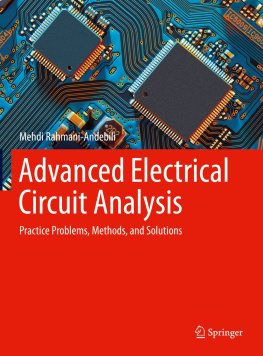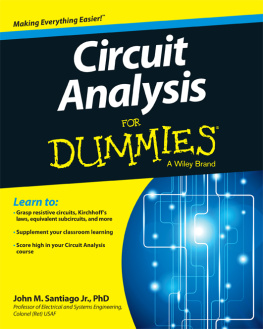Richard (Bob) Hope - Advanced Circuit Training A Complete Guide to Progressive Planning and Instructing
Here you can read online Richard (Bob) Hope - Advanced Circuit Training A Complete Guide to Progressive Planning and Instructing full text of the book (entire story) in english for free. Download pdf and epub, get meaning, cover and reviews about this ebook. year: 2020, publisher: Bloomsbury Publishing, genre: Romance novel. Description of the work, (preface) as well as reviews are available. Best literature library LitArk.com created for fans of good reading and offers a wide selection of genres:
Romance novel
Science fiction
Adventure
Detective
Science
History
Home and family
Prose
Art
Politics
Computer
Non-fiction
Religion
Business
Children
Humor
Choose a favorite category and find really read worthwhile books. Enjoy immersion in the world of imagination, feel the emotions of the characters or learn something new for yourself, make an fascinating discovery.

- Book:Advanced Circuit Training A Complete Guide to Progressive Planning and Instructing
- Author:
- Publisher:Bloomsbury Publishing
- Genre:
- Year:2020
- Rating:3 / 5
- Favourites:Add to favourites
- Your mark:
- 60
- 1
- 2
- 3
- 4
- 5
Advanced Circuit Training A Complete Guide to Progressive Planning and Instructing: summary, description and annotation
We offer to read an annotation, description, summary or preface (depends on what the author of the book "Advanced Circuit Training A Complete Guide to Progressive Planning and Instructing" wrote himself). If you haven't found the necessary information about the book — write in the comments, we will try to find it.
Richard (Bob) Hope: author's other books
Who wrote Advanced Circuit Training A Complete Guide to Progressive Planning and Instructing? Find out the surname, the name of the author of the book and a list of all author's works by series.
Advanced Circuit Training A Complete Guide to Progressive Planning and Instructing — read online for free the complete book (whole text) full work
Below is the text of the book, divided by pages. System saving the place of the last page read, allows you to conveniently read the book "Advanced Circuit Training A Complete Guide to Progressive Planning and Instructing" online for free, without having to search again every time where you left off. Put a bookmark, and you can go to the page where you finished reading at any time.
Font size:
Interval:
Bookmark:

The aim of this book is to build on the information provided within the Fitness Professionals: Circuit Training A Complete Guide to Planning and Instructing, which was aimed at instructors qualified to Level 2 National Occupational Standards (NOS). Specifically, this book aims to:
Develop instructor knowledge base in relation to each of the components of physical fitness to Level 3 of the NOS.
Improve the understanding of the relationship between basic exercise and fitness knowledge and the components of fitness.
Introduce different types of equipment that can be integrated into an advanced circuit training session.
Provide exercise ideas with illustrations and descriptions, that focus on delivering more advanced circuit training programmes.
Review safety considerations for delivering advanced circuit programmes/exercises.
Introduce instructors to skill and learning theories that represent the knowledge required from a Level 3 instructor.
The information in this book represents knowledge required to meet the stated learning outcomes within the National Occupational Standards (NOS) and Common Units for Fitness Instruction (Level 2 and 3). This information can be applied in a number of different training contexts exercise to music, gym-based exercise etc. The aim of this book is to discuss the concepts generally and then apply them to circuit training.
NOS Level 2 instructing exercise and fitness
Unit C35: deal with accidents and emergencies
Unit D416: evaluate coaching sessions and deal with personal coaching practice
Unit D417: support participants in developing and maintaining fitness
Unit D414: plan and prepare a group exercise with music session
Unit D415: instruct a group exercise with music session
NOS Level 3 instructing exercise and fitness
Unit D437: collect and analyse information to plan a progressive physical activity programme
Unit D438: plan, review and adapt a progressive physical activity programme
Unit D439: plan and instruct specific physical activity programmes (ETM)
Unit C313: provide motivation and support to clients during a progressive physical activity programme
Unit A318: manage, evaluate and improve your own performance in providing physical activity
Unit D444: integrate core stability and flexibility activities into a physical activity programme
NOS Level 3 core exercise and fitness knowledge
Behaviour change
Anatomy
Functional kinesiology
Energy systems
Concepts and components of fitness
NB: copies of the Award Body Common Units and National Occupational Standards can be obtained from the Sector Skills Council (Skills Active) and/or the Register of Exercise Professionals (REPs).
Recommendation from the authors
As with all exercise programmes, there should be a focus on using correct exercise technique and posture! The equipment and exercises described in this book are specifically targeted at advanced exercisers who train frequently, are able to perform with safe exercise technique and have no specific medical conditions. This may include individuals who are serving within the armed forces, trained athletes and sport people.
To state what is hoped to be the obvious, these exercises are NOT recommended to be used when training beginners, people who are unused to training, children, older adults, special populations or people with specific medical conditions!
Physical fitness incorporates a number of components. These include cardiovascular fitness, muscular strength, muscular endurance, flexibility and motor fitness.
Physical fitness can be improved by performing an appropriate volume (frequency, intensity, time) of specific types of exercises and activities that are appropriately structured and planned.
The volume of exercise undertaken by individuals will be determined by:
Specified training goals
Current fitness level
Current levels of activity and training
Individual differences (age, body type etc)
Any special consideration (medical conditions etc)
reviews the principles and variables for progressive fitness training progressive overload, frequency, intensity, time, recovery periods, reversibility, specificity, individual differences that affect performance and response to training.
discusses cardiovascular training theory the aims and benefits of cardiovascular (CV) training, training guidelines, methods of monitoring intensity, energy systems, progressive methods, different types of training.
discusses flexibility training the aims and benefits, training guidelines, factors that influence flexibility, different types of stretching, progressive methods.
discusses muscular fitness training (strength and endurance) aims and benefits, physiological changes, training guidelines, progressive methods, different training approaches.
looks at motor skills training (power, speed, balance, agility etc) with a brief introduction to the nervous system.
There are a number of principles and variables that need to be considered to ensure training programmes are both effective and safe. These include:
Progressive overload (frequency, intensity, time)
Recovery time
Reversibility
Specificity
Individual differences (body type, age, gender etc)
This chapter introduces each of the variables and highlights specific considerations that need to be made when planning and designing fitness programmes. These considerations are explored in more detail in subsequent chapters.
Progressive overload
In order to progress, it is essential to make the body work a little bit harder than it has been used to working. This is achieved by increasing the volume of work (frequency, intensity, time) and also balancing training sessions with sufficient rest and recovery time.
The level of overload applied will be determined by the fitness goals of the individual and their current workload and fitness levels. A trained athlete will need a greater challenge to bring about improvements than an untrained, sedentary person, who may need very small incremental changes to bring about a training effect.
Rest and recovery
Rest and recovery time is essential to prevent over training. Factors that may influence the rest and recovery time needed may include the volume of exercise and also the fitness level of the individual. Periodised training programmes offer a method for structuring a workout plan to ensure sufficient volume of activity and rest. These are discussed in .
For example:
An elite athlete may have a higher volume of work. They need sufficient rest time to enable the body to heal. An untrained person would have a lower volume of work, but their body may need longer to recover because it is unused to the specific training demands being made.
The specific component being trained may also influence the rest and recovery time needed. This is discussed in relation to frequency of training.
Frequency how often we train
It is essential to train at an optimal frequency to achieve benefits from specific training regimes. Optimal frequency of training, to improve specific components of fitness, is explored in this chapter.
For some components of fitness, training more frequently is beneficial. For example, stretching daily can provide greater improvements for flexibility than stretching on the minimum requirement of two to three days a week. However, for other components of fitness, rest time is needed between sessions to enable muscles to recover from the workout.
Font size:
Interval:
Bookmark:
Similar books «Advanced Circuit Training A Complete Guide to Progressive Planning and Instructing»
Look at similar books to Advanced Circuit Training A Complete Guide to Progressive Planning and Instructing. We have selected literature similar in name and meaning in the hope of providing readers with more options to find new, interesting, not yet read works.
Discussion, reviews of the book Advanced Circuit Training A Complete Guide to Progressive Planning and Instructing and just readers' own opinions. Leave your comments, write what you think about the work, its meaning or the main characters. Specify what exactly you liked and what you didn't like, and why you think so.










